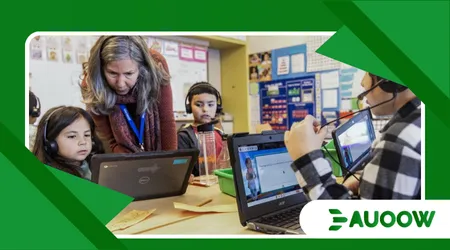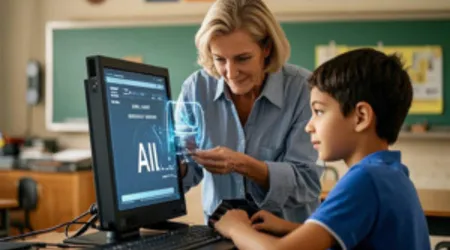AI Tutors for Students with Disabilities: Effective or Overhyped?

AI Tutors for Students with Disabilities represent one of the most transformative, yet intensely debated, frontiers in inclusive education in 2025.
The promise is profound: technology capable of delivering truly personalized instruction, adapting dynamically to the unique cognitive, physical, or emotional needs of every learner, something often unattainable in under-resourced classrooms.
We must critically examine if these intelligent systems genuinely level the playing field or if they risk becoming another layer of technological complication.
The discourse around these tools centers on their capacity for individualization a cornerstone of effective special education.
While human teachers juggle diverse needs, AI offers a scalable alternative that can theoretically provide infinite patience and immediate, tailored feedback.
Yet, the complex needs of students with disabilities demand a nuanced look at efficacy, ethics, and emotional connectivity, requiring us to move beyond the enthusiastic marketing.
What Are the Key Advantages of AI Tutors for Inclusive Learning?
How Does AI Facilitate True Personalization for Neurodiverse Students?
AI’s core strength lies in its ability to process vast amounts of data in real-time, allowing it to move far beyond static, one-size-fits-all curricula.
These systems analyze a student’s response speed, error patterns, and preferred modalities to dynamically adjust the lesson’s pace and presentation.
For a student with dyslexia, for example, the AI can instantly switch from text to high-contrast audio-visual content, a degree of adaptation simply impossible for a human teacher managing twenty students.
Intelligent Tutoring Systems (ITS) can also simplify complex instructions into “bite-sized” segments and offer continuous, non-judgmental repetition, which is invaluable for students with ADHD or mild intellectual disabilities who benefit from structured, predictable environments.
This continuous adaptation helps mitigate frustration, building confidence through a personalized path to mastery.
++ Assistive EdTech: Top Tools Helping Students Learn
Why Do AI Tutors Improve Engagement and Accessibility?
AI Tutors for Students with Disabilities can dramatically increase engagement by leveraging interactive, multimodal content, often in gamified formats.
Students who struggle with traditional reading and writing common challenges across the disability spectrum can utilize speech recognition, virtual reality, and interactive simulations that bypass core barriers. This shifts the focus from their deficit to their strengths.
Read more: Why Inclusive Education Is Key to Achieving the SDGs by 2030
Furthermore, AI-driven platforms guarantee access to instruction anytime and anywhere, transcending the physical limitations of the traditional classroom and the availability of specialized human tutors.
This accessibility is a game-changer for home-schooled students with medical vulnerabilities or those in remote areas lacking special education specialists, ensuring continuity and consistency of instruction regardless of external factors.

What Are the Real-World Effectiveness and Statistics?
Do Studies Confirm the Positive Impact of AI Interventions?
Recent, rigorous studies confirm the significant potential of AI interventions in specific learning domains.
A systematic review published in 2025 focusing on AI-based interventions for students with learning disabilities reported unequivocally positive outcomes across eleven studies.
These results are encouraging, providing empirical support for AI’s role in the inclusive classroom.
The research highlighted that personalized/adaptive learning systems and game-based learning yielded large effect sizes in improving skills like arithmetic fluency and reading comprehension, especially for students with dyslexia and other specific learning disorders.
However, while these initial quantitative results are powerful, they primarily address specific skill gains, not the holistic educational experience.
Also read: Equity vs Equality in Schools: What Policies Actually Work?
What Specific Tools and Methods Are Proving Most Effective?
The most effective tools leverage generative AI and Natural Language Processing (NLP) to create customized support aids.
Text simplification tools based on AI are proving vital for students with comprehension issues, while chatbots and virtual avatars are being employed to support social and communication skill acquisition for individuals with neurodivergence.
| AI Tutoring Feature | Benefit for Disabled Students | Target Disability Examples |
| Dynamic Adaptation | Real-time adjustment of pace and complexity. | Mild Intellectual Disability, ADHD |
| Multimodal Delivery | Converts text to audio/visuals instantly. | Dyslexia, Visual Impairments |
| Non-Judgmental Feedback | Unlimited repetition without human bias/fatigue. | Autism Spectrum Disorder (ASD), Anxiety |
| Structured Routine | Provides predictable learning pathways. | ASD, Emotional Disturbance |
What Are the Ethical and Practical Challenges of AI Tutors?
Why Do Biases in AI Algorithms Threaten Educational Equity?
A significant ethical hurdle for AI Tutors for Students with Disabilities is the pervasive risk of algorithmic bias.
AI systems are trained on datasets that often lack sufficient representation of neurodiverse individuals, leading to models that make inaccurate estimations or provide less-than-optimal support systems.
If the training data is skewed towards ‘typical’ learners, the system may misinterpret the learning patterns of a student with a disability, potentially reinforcing existing educational disparities instead of alleviating them.
Moreover, the “black box” nature of some sophisticated AI models makes it nearly impossible for teachers or parents to understand why a decision was made or how a specific intervention was chosen.
This lack of transparency undermines the accountability essential in special education, where instructional decisions must be explainable and justifiable to parents and legal oversight bodies.
How Does Over-Reliance on AI Hinder Human Development?
The risk of over-reliance is a genuine concern, threatening to diminish the critical development of interpersonal skills and the vital teacher-student relationship.
Half of students in a recent survey reported feeling less connected to their teachers when using AI in class, according to an Education Week report in 2025.
For students with disabilities who often require social-emotional support and explicit instruction on social skills, reducing human interaction can be detrimental.
The human element of teachingempathy, mentorship, and motivational encouragement is irreplaceable.
If AI Tutors for Students with Disabilities lead to reduced human oversight, the emotional and contextual needs of the learner may be overlooked, substituting data efficiency for genuine, holistic care.
Addressing the Integration: The Path to Effective Deployment
What Analogies Best Illustrate the Role of AI in Special Education?
The best analogy for the role of AI in special education is that of a High-Powered Personal Trainer, not a replacement for the Coach.
A personal trainer (the AI) provides the specialized tools, real-time data, and customized workout plan to maximize physical gain.
However, the Coach (the human teacher) provides the inspiration, checks for mental burnout, adjusts the long-term vision, and ultimately cares about the athlete’s well-being beyond the data points.
AI is a tool for enhanced instruction, not a substitute for the human teacher.
It should handle the repetitive, data-intensive tasks like grading and basic drills freeing up the human educator to focus on complex emotional support, strategic differentiation, and fostering social connection.
The Customized Learning Pathway for a Student with ADHD
Consider a 7th-grade student with ADHD who struggles to maintain focus during long reading assignments.
An AI tutor customizes the assignment by breaking the text into three-minute chunks, inserting micro-quizzes after each segment, and providing immediate, positive-reinforcement animated feedback (e.g., a celebratory icon).
If the student’s keystroke data shows distraction, the AI automatically inserts a personalized, two-minute movement break reminder.
This level of dynamic, proactive intervention ensures that the learning process accommodates the disability in real-time.
Bridging the Communication Gap for Non-Verbal Students
Another compelling application involves an AI-powered communication tool for a non-verbal student with Autism.
The system analyzes the student’s eye-gaze patterns and selected images to generate natural-sounding, context-appropriate sentences in a synthetic voice.
It learns to anticipate their needs and structure complex thoughts, effectively acting as an intelligent bridge that amplifies the student’s voice and inclusion in group activities, a powerful stride towards genuine integration.
Conclusion: Balancing Innovation with Humanity
AI Tutors for Students with Disabilities offer revolutionary capabilities for personalization and access, backed by initial data showing tangible academic gains.
However, we cannot allow the promise of technological efficiency to overshadow the ethical imperative for human-centered, equitable, and empathetic education.
The ultimate effectiveness of these tools hinges not on their computing power, but on their transparent design, unbiased training data, and the willingness of educators to use them as assistive tools rather than replacements for human connection.
The future of inclusive education depends on this thoughtful integration.
The question remains: Are we committed to developing AI Tutors for Students with Disabilities with the necessary safeguards for every unique mind?
Frequently Asked Questions (FAQ)
What is an Intelligent Tutoring System (ITS)?
An Intelligent Tutoring System (ITS) is an AI program designed to mimic a human tutor.
It uses machine learning to adapt lessons, provide personalized feedback, and adjust the curriculum’s difficulty and content based on a student’s real-time performance and learning patterns.
Is AI safe for handling sensitive student disability data?
The use of AI raises significant concerns regarding privacy and data security.
Ethical AI use mandates stringent data protection measures, ensuring that a student’s personally identifiable information and sensitive disability data are not used to train AI models without explicit, informed consent.
Parents and educators must demand transparency on data protocols.
How can AI help a student with Dyslexia specifically?
AI can be immensely helpful by offering text-to-speech conversion, text simplification, predictive text functionalities, and grammar/spelling checks that adapt to common dyslexic errors.
It can also switch content to high-contrast, dyslexia-friendly fonts and backgrounds instantly, removing a major reading barrier.
What is the biggest risk of using AI in special education?
The biggest risk is the potential for algorithmic bias leading to unfair or inaccurate support.
Since AI learns from data, if that data poorly represents the diverse needs of students with disabilities, the resulting AI intervention may not only fail to help but could actively worsen learning outcomes or reinforce stereotypes.
What is the ‘black box’ problem in AI and why is it an ethical concern?
The ‘black box’ refers to complex AI systems whose decision-making process is opaque and cannot be easily explained by humans.
In special education, this is a major ethical concern because parents and educators must be able to understand and challenge why an AI tutor prescribed a certain intervention for a student. Transparency is non-negotiable in this field.
